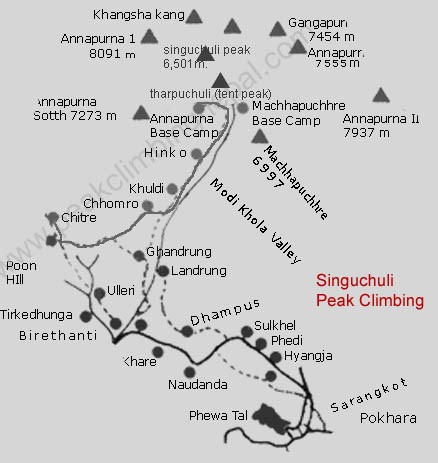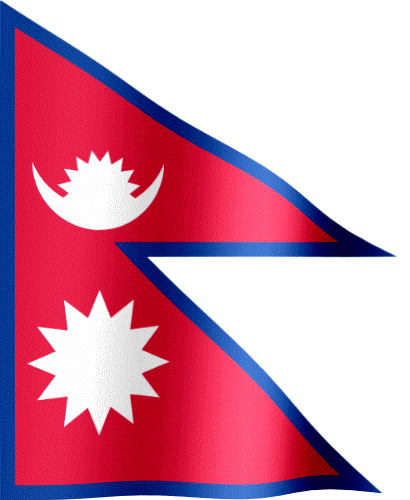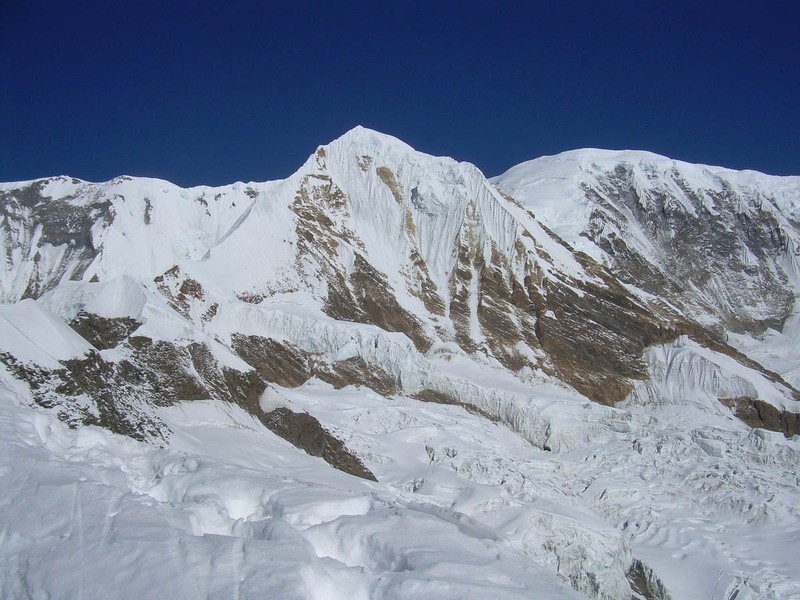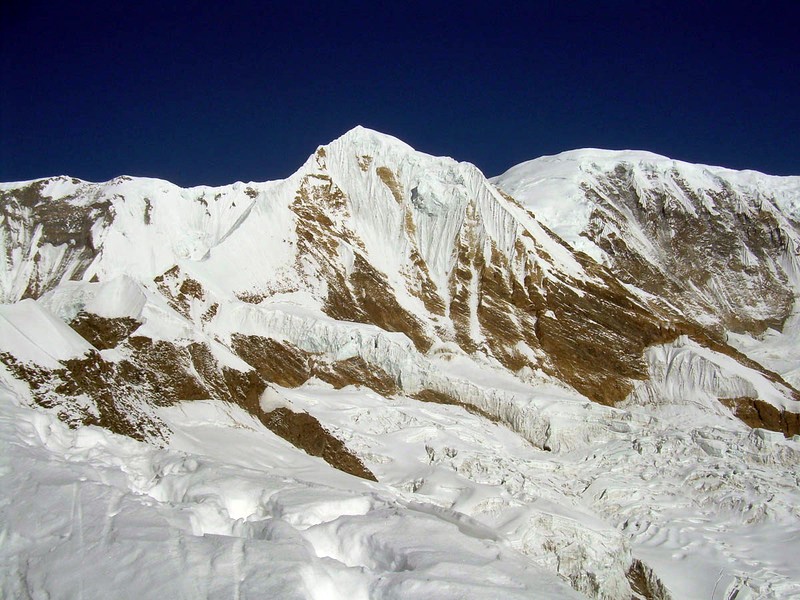Reference Code: MSCNP
Trip Start: Kathmandu
Trek Start: Nayapul
Trek Days: 16 days
Peak Climbing Period: 5 days
Maximum Altitude: 6501m.
Age: 20-60
Season: Spring and Autumn
Accommodation: Lodge and Camp
Service: Full Board
Destination: Nepal
Trip End: Kathmandu
Trek End: Phedi
Trip Durations: 22 Days
Peak Grade: Extreme
Physical Rating: Strenuous
Group Size: 2-10
Theme: Expedition
Meals: Standard
Mt. Singu Chuli / Flute Peak(6,501m) was formerly known as the 'Flute Peak'. This peak situated in the Annapurna Sanctuary adjoined to Tharpu Chuli and across Hiunchuli peaks. Wilf Noyce and David Cox made the first ascent of this peak. They have made it from its Northeast Face and the top section of the East Ridge.
For Climbing Singu Chuli peak, walk up the Modi Khola gorge to the Annapurna Sanctuary. Base camp at around 4350m and then establish two higher camps, one at 4,900m at the approach of North East Face and a higher one at 5,500m on the North East Face of the mountain before catching the summit. A vertical wall near the summit fronts some technical challenges on this climb. Singu Chuli Peak climb is suggested to only those with some alpine and ice climbing experience. This mountain is a much stiffer proposition than Tharpu Chuli, and is the highest of all the trekking peaks in the area. There are no straightforward routes up the mountain. This trek strongly recommended for real upfront excellent mountain views.
You will enjoy the great cultural experiences in Ghandruk and Chhomorong while approaching to the Peak. Before entering the Fish Tail (Machhapuchhare Base Camp) and Annapurna Base Camp, you can relax for a while and enjoy the panoramic views of world's higher mountains. Attempting this peak is thrilling adventure to its core.
Adventure Zambuling offers full board package for this Mt. Singu Chuli Peak climbing as a unique adventure including climbing permit from NMA Peak B and all other necessary logistics form arrival up to departure from Kathmandu.
Day 01 Arrival in Kathmandu
Namaste! And welcome to Kathmandu, the colourful capital of Nepal where ornately carved balconies mingle with beautiful shrines and temples. Your adventure begins with a welcome meeting on arrival at the exit gate of Kathmandu airport. Our staff will welcome you and pick you to your accommodated hotel. Please seek our company palmplate to find our staff at the main exit gate of the airport. Rest of the day you can relax at the hotel or short evening walk around local market on your own as per your wish.
Approximate Driving Hours: 30 minutes
Accommodation: Hotel
Meals include: None
Day 02 Rest, NMA peak permit issue and preparation day
A well deserved rest day at cosy of hotel after a long tiring flight. This day, one can move around nearby local market to purchase or hire trekking equipment that is necessary for the trekking like sleeping bags, walking sticks etc, exchange currency as requirement or simply walk around in the local market or Kathmandu Durbar squire nearby with small entrance fee as per your preference on your own. In this day our staff will issue NMA Peak climbing permit. Evening at the hotel lobby there will be pre-trip briefing in which you will be introduced with your trekking guide and explained about your trip in short, instruction for safety etc.
Accommodation: Hotel
Meals include: Breakfast
Day 03 Drive to Pokhara 820m.
Leaving Kathmandu behind early this morning, journey to the enchanting Nepalese town of Pokhara by private vehicle (approximately 7 hours). Pokhara enjoys a delightful setting on a lake beneath the snow-capped peaks of the Annapurna range, making it an excellent place to relax and contemplate what lies ahead. Pokhara is part of a once vibrant trade route extending between India and Tibet. This is the land of Magars and Gurungs – hardworking farmers and valorous warriors who have earned world-wide fame as Gurkha soldiers. The Thakalis, another important ethnic group here, are known for their entrepreneurship. This afternoon you’ll have your trek briefing and preparation, but depending on your arrival time, there may be time to hire a small boat for a quick paddle on the lake. There are also plenty of cafes where you can put your feet up and enjoy international cuisine, while the main street is full of shops and stalls selling a wide range of Nepali and Tibetan souvenirs. If you need to hire some extra trekking gear, then there are numerous shops available offering everything you could possibly need.
Driving Hours: 5-6 hours
Altitude gain/loss:
Accommodation: Hotel
Meals include: Breakfast,
Day 04 Drive to Nayapul 1070m. and trek to Ulleri 2080m.
At 8091 metres, Annapurna 1 is one of the highest mountains in the world. Its surrounding sister mountains are equally imposing and create magnificent panoramas from any viewpoint. This trek covers a wide variety of terrain, from lowland pastures and peaceful villages to powerful glaciers and stunning mountain views. In the rugged mountain scenery, you stay in mountain communities and meet friendly Nepali hill people as they go about their daily lives. The expedition is not only visually superb but also a chance to learn about local cultures. Along the way, see thundering waterfalls of melted snow, cross icy rivers and reward yourself with a soak in natural hot springs. An hour-long drive (remember driving times are always approximate in Asia – patience is your closest friend!) brings you to Nayapul where you commence your trek. Gear up and follow the Bhurungi Khola to Thikhedhunga, trek through farmland before a steep ascent to reach Ulleri.
Driving Hours: 1 hours Walking Hours: 5 hours
Altitude gain/loss:
Accommodation: Lodge
Meals include: Breakfast,, Lunch and Dinner
Day 05 Trek to Ghorepani 2750m.
Ascend to Ulleri Village through a pleasant rhododendron forest, much more impressive than the trees your grandmother has in the garden! Stay overnight at Ghorepani.
Walking Hours: 6 hours
Altitude gain/loss:
Accommodation: Lodge
Meals include: Breakfast,, Lunch and Dinner
Day 06 Ascent Poon Hill 3210m. and trek to Tadapani 2700m.
Early birds can bounce out of bed to witness the sunrise over Annapurna from nearby Poon Hill (1-hour uphill climb) – you have to do this at least once in your life, right? Then the adventure continues as you continue your trek on to Tadapani.
Walking Hours: 5 hours
Altitude gain/loss:
Accommodation: Lodge
Meals include: Breakfast,, Lunch and Dinner
Day 07 Trek to Chhomrong 2177m.
This morning you’ll descend to Kimrung Khola before climbing again to Chomrong village, at the base of Hiunchuli (6441 metres). There are breathtaking views of Annapurna and Macchhapucchhre from here, plus delicious pizza!
Walking Hours: 4 hours
Altitude gain/loss:
Accommodation: Lodge
Meals include: Breakfast,, Lunch and Dinner
Day 08 Trek to Doban 2670m.
Begin by trekking for approximately 3 hours through the forest to Kuldi Ghar, then down to the banks of the Modi River and up again to Doban.
Walking Hours: 7 hours
Altitude gain/loss:
Accommodation: Lodge
Meals include: Breakfast,, Lunch and Dinner
Day 09 Trek to Machhapuchre Base Camp 3700m.
Passing through Himalaya Hotel, continue up the narrow valley to Deurali. Sticking to the west bank of the Modi River, enter an open valley near Machhapuchhre Base Camp
Walking Hours: 6 hours
Altitude gain/loss:
Accommodation: Lodge
Meals include: Breakfast,, Lunch and Dinner
Day 10 Exploration day to Annapurna Base Camp 4130m.
Ascend further from Machhapuchhre Base Camp to Annapurna Base Camp, the highest point of your trek. You can decide how your legs and your lungs are holding up. Later you return to Machhapuchhre Base Camp for the night. The views from the base camps are fantastic – all the hard work to get here is worth it!
Walking Hours: 2 hours
Altitude gain/loss:
Accommodation: Lodge
Meals include: Breakfast,, Lunch and Dinner
Day 11 Trek to Singu Chuli Base Camp 4000m.
Walking Hours:
Altitude gain/loss:
Accommodation: Camp
Meals include: Breakfast,, Lunch and Dinner
Day 12 Rest, basic climbing training and preparation day
This day most of the time we rest at our camp. Afternoon, the climbing support sherpa will brief the team about peak climbing skill and safety on the mountain. After that we will check all our group and personal climbing equipment.
Accommodation: Camp
Meals include: Breakfast,, Lunch and Dinner
day 13 Trek to High Camp 4600m.
Walking Hours:
Altitude gain/loss:
Accommodation: Camp
Meals include: Breakfast,, Lunch and Dinner
Day 14 Trek to Camp I 5600m.
Walking Hours:
Altitude gain/loss:
Accommodation: Camp
Meals include: High Altitude food
Day 15 Trek to Camp II
Walking Hours:
Altitude gain/loss:
Accommodation: Camp
Meals include: High Altitude food
Day 16 Summit Singu Chuli 6501m. and descend to Base Camp 4000m.
Walking Hours:
Altitude gain/loss:
Accommodation: Camp
Meals include: High Altitude food/ Dinner
Day 17 Trek to Bamboo 2335m.
Wake up early for the beautiful sunrise view in Base Camp! You're close enough now to (almost!) reach out and touch the peaks of Annapurna 1, Macchapucchhre, Annapurna South, Tent Peak, Gangapurna, Himchuli and Annapurna 3. After watching a sunrise on these snowy peaks, head back down the valley the same way to Bamboo (or further if the knees can handle it). It’s a long day but you have plenty of time to get there.
Walking Hours: 6 hours
Altitude gain/loss:
Accommodation: Lodge
Meals include: Breakfast,, Lunch and Dinner
Day 18 Trek to Jhinu Danda 1780m.
Passing back through the up and down staircases of Chhomrong, continue the decent to Jhinu Danda. From here it's a 20-minute walk down to a hot spring by the Modi Khola for a well-deserved rest.
Walking Hours: 6 hours
Altitude gain/loss:
Accommodation: Lodge
Meals include: Breakfast,, Lunch and Dinner
Day 19 Trek to Pothana 1970m.
By now you’ll have thighs of steel and will be pretty good at carrying your pack! Trek down to cross the river and continue the ascent to Landruk,Tolkha, Deurali and Pothana. This is the last night of the expedition and we will celebrate the success of the expidtion with all the Nepales staff altogether.
Walking Hours: 6 hours
Altitude gain/loss:
Accommodation: Lodge
Meals include: Breakfast,, Lunch and Dinner
Day 20 Trek To Phedi 1130m. And Drive To Pokhara 820m.
This is the final day of the trek and it is a short downhill stretch all the way from Pothana to Phedi (approximately 1.5 hours) via Dhampus village – you made it! After lunch it's only about a 45 minute drive to Pokhara to check into your hotel for a well-earned shower and an end-of-trek celebration to enjoy the good things in life – like cold beer or cocktail!
Walking Hours: 1.5 hours Driving Hours 45 minutes
Altitude gain/loss:
Accommodation: Hotel
Meals include: Breakfast
Day 21 Rest and final shopping day
Enjoy a free day in Pokhara to unwind, relax, and give those muscles a rest after all that trekking. Your leader can advise you of sightseeing opportunities. It is worth taking a boat for a row out on the lake, especially if the weather's fine. The lakeside area has great shopping and cafes. Pokhara has an interesting old area as well as an elaborate Hindu temple and a Buddhist monastery. Perhaps visit the Peace Pagoda, where spectacular views of the mountains await. You can see the Annapurnas from here, and the famous fishtail peak, Machhapuchhare, and back across to Pokhara. You can also visit the fascinating International Mountain Museum to learn some amazing tales of past climbing expeditions.
Accommodation: Hotel
Meals include: Breakfast
Day 22 Drive to Kathmandu 1350m.
Around 9 am we drive to Kathmandu through Prithvi Highway and Tribhuwan Highway with the bank of Marsyangdi river first, then to Daraudi River and Trishuli River. The lenght of the road is 201 km.
Driving Hours 5 hours
Altitude gain/loss:
Accommodation: Hotel
Meals include: Breakfast and Lunch
Day 23 Final departure
We say 'Namaste' for memories that will last a lifetime. There are no activities planned for today and you are able to depart the hotel at any time. Check out time from the hotel is at 12 noon. If you are departing later, you can arrange luggage storage at the hotel. For your final departure, our staff will pick you up from the hotel and transfer to Kathmandu airport approximately 3 hours prior to your international flight time.
Driving hours: 40 minutes
Meals include: Breakfast
Inclusion
Lodge/Camping Basis
All ground transportation as per itinerary
3 night hotel accommodation in Kathmandu with B/B plan.
3 night hotel accommodation in Pokhara with B/B plan.
TIMs (Trekking Information Management system) card
Annapurna Conservation Area Entry fee
Peak climbing permit
Food for the members on Lodge/Camping basis
Lodge charges
All camping equipment and camping charges during climbing period
All required group climbing equipments( like fixed ropes, man rope, ice bar, ice screw.....)
All required Nepalese staffs including climbing support sherpa
Climbing support Sherpa equipments
All Nepalese staffs insurance
Company service charge and government taxes etc.
Exclusion
International flight with airport tax.
Nepalese Entry Visa fee
Food during stay in Kathmandu and Pokhara
All personal equipment and personal expenses
All personal climbing gears
Photography Charges, Monument charges and Monument entry fees
Personal Medical and travel insurance(must cover helicopter rescue evacuation cost)
Personal Medicine
Telephone and internet charges
Laundry charges
Alcoholic beverage, bottled drinks and cold drinks during the trip
Rescue evacuation charges if required
Staff and porters Tips...
Equipment List
This trekking equipment list has been prepared by Adventure Zambuling Treks (P) Ltd.
Climbing equipment:
» Climbing harness;
» One 3 metre/10 foot sling and three 2 metre/6 foot slings.
» Figure 8/Abseil belay device;
» 1 large mitten sized ascender (most members use the large petzl) and arm length leash;
» 2 locking carabiners, (1 large and 1 small)
» 4 regular carabiners;
» Good quality Ice axe with leash;
» Crampons - must fit boots perfectly. Steel crampons with anti-balling (anti-bot) plates are the best;
» Optional; Adjustable trekking poles;
Upper Body:
» 2 cotton t-shirts;
» 1 polypropylene t-shirt;
» 1 long sleeve polypropylene shirts, lightweight;
» 1 polar fleece pullovers, medium weight;
» 1 polar fleece jacket.
» Gore-Tex jacket with hood, waterproof and breathable;
» Lightweight down jacket for those chilly days in camp;
Hands:
» 1 pr. lightweight poly-liner gloves. These will be worn when tying knots, but not inside your mitts;
» 1 pair mittens, consists of 1 Gore-tex over mitt matched with the very warm polar fleece mitt liner (For more about high altitude mitts.
Head:
» Warm hat wool or synthetic that covers your ears;
» Balaclava;
» Face mask;
» Ballcap or brimmed suncap;
» Glacier sunglasses with side shields (you can purchase these inexpensively in Kathmandu,
» 1 pair ski goggles (Optional) with light and dark lens;
» Headlamp with extra batteries and bulbs;
» Bandana or head scarf, also useful for dusty conditions.
Lower Body:
» Cotton underwear briefs;
» 1 pair walking shorts;
» 1 pair walking trousers for trekking and around camp;
» 1 pair lightweight thermal bottoms;
» 1 pair medium or expedition weight thermal bottoms;
» 1 pair polar fleece trousers;
» 1 pair Gore-Tex trousers, salopettes, or bibs. Waterproof/breathable with full side zips;
Your clothing should be kept dry using waterproof stuff sacks, bin-liners, or large plastic bags.
Feet:
» 1 pair Double Plastic boots (Koflach);
Modern single waterproof-leather climbing boots with special insulation for cold weather/winter climbing on 4000 metre/13,000 foot high peaks are OK, as long as they will fit comfortably with two thick pair of socks and a vapour barrier liner and the boot will fit the crampon perfectly.
» 1 pair sturdy leather walking boots with good ankle support (we mean leather trekking, not climbing boots) for the trek;
» 1 pair trainers, running shoes and/or sandals for Kathmandu and in camp;
» 1 pair down booties (optional);
» 2 pair med-heavy poly or wool socks;
» 2- pair of liner socks. Polypropylene or wool;
» Vapour barrier liner socks or plastic bread-bags;
» 2 pair lightweight trekking socks, poly or wool;
» Cotton socks for in town.
Sleeping:
» 1 good quality sleeping bag (good to -30 degrees C)
» At least 1 closed cell foam kari-mats. We do not recommend inflatable mats, as we have never seen one not puncture. You can buy these non inflatable mats very inexpensively in Kathmandu. Why carry foam mats around the world, when you can purchase them inexpensively in Kathmandu?
Your sleeping bags should be kept dry using waterproof stuff sacks, bin-liners, or large plastic bags.
Rucksack and Travel Bags:
» 1 medium rucksack (50-70 litres / 3000-4500 cubic inches, can be used for airplane carry);
» 1 or 2 large (120 L / 7500 cubic inch) duffle kit bags for clothing and equipment. Must be durable for use on pack animals or porters;
» Small padlocks for duffel kit bags.
Personal Hygiene:
» female or male hygiene supplies;
» 2 tubes lip sun cream, 1 large tube skin sun cream (min.factor 15);
» anti-mosquito cream;
» 1 toothpaste/brush;
» 1 bar soap or hand sanitizer gel/1 small towel;
» hand wipes.
Medical:
Medications are inexpensive and readily available in Kathmandu with no Doctor`s prescription:
» small personal first-aid kit. (Simple and Light) Aspirin, first-aid tape, plasters (band-aids), personal medications, etc. The leaders will have extensive first-aid kits, so leave anything extra behind. Please let your leader know about any medical issues before the climb;
» 1 skin blister repair kit;
» 1 small bottle anti-diarrhea pills;
» 1 small bottle anti-headache pills;
» 1 small bottle cough and/or cold medicine;
» 1 small bottle stomach antibiotic: Ciprofloxacin, etc.;
» 1 small bottle anti-altitude sickness pills: Diamox, Acetylzolamide.
» Do not bring sleeping pills. They are a respiratory depressant;
» 1 small bottle of water purification tablets or water filter;
» 1 set earplugs;
» Extra prescription glasses, contact lens supplies. Contact lens wearers, please bring glasses in case of emergency. A new pair could be quickly made in Kathmandu, Lhasa, or Kashgar for just $20. Please order upon arrival if you are interested.
Personal Food:
On the mountain we supply plenty of food for you to cook 3 hot meals each day. This food will consist of soup, local cheese & sausage, biscuits, dried noodles, potatoes, rice, porridge, butter, dried and tinned vegetables, fruit, meats, and fish, tea with milk and sugar, powdered juice drink, and drinking chocolate. Our sherpas/local porter will be carrying this food to the higher camps.
» We ask each member to bring their own imported daily snack and energy foods. We do not provide cold “snack” food such as chocolate or "energy-bars". We ask that you bring or buy your own "snack" or daily cold energy food, 2-3 kilos/4-6 pounds is a good amount (for the trek and Island Peak combined). A growing variety of imported foods such as European and American cheeses, chocolates, biscuits, cookies, nuts, and locally made power-bars are now available in Kathmandu, at realistic prices. However, imported power bars, GU, re-hydration drinks, dehydrated food, "freeze-dried meals", imported cheese and sausage are not available. If you want these items, you must bring them from your home country. Many of our members, especially Britons, Europeans, and Australians with tiny baggage allowances, now purchase their daily snacks in Kathmandu. Our schedule in Kathmandu allows plenty of time for shopping.
Practical:
» 1 small roll of repair tape, 1 sewing repair kit;
» 1 cigarette lighter, 1 small box matches;
» 1 compass or GPS;
» Recent good quality map of visiting area.
» 1 battery powered alarm clock/watch;
» 1 camera and film, or digital camera with extra cards and extra batteries;
» nylon stuff sacks For food and gear storage, large Ziplocs are useful also;
» 3 Water bottles (1 litre) wide-mouth Nalgene (1 is a pee bottle);
» 1 plastic cup and spoon;
» 1 small folding knife;
» binoculars (optional);
» 4 large, waterproof, disposable rubbish sacks;
» passport, 2 extra passport photos, flight ticket, flight itinerary;
» separate photocopies of passport and relevant visa pages, proof of insurance;
» dollars, pounds or euros cash for purchasing Nepalese visa at Kathmandu airport, Tibet visa, for paying for restaurants and hotels, for gratuities, snacks, and to purchase your own drinks and gifts;
» credit cards, Bank/ATM/Cash machine cards for use for withdrawing funds from cash machines (bring a photocopy of your cards), traveler's checks, etc.;
» 1 bathing suit/swimming costume (you never know);
» basecamp entertainment. It is good to bring additional items which you have found to be useful on previous expeditions. For example: paperback books, playing cards, ipod mp3 player, short-wave radio, game boys, musical instruments, ear plugs, lots of batteries, etc.;
» travel clothes for basecamp and in town;
This Peak Climbing equipment list has been prepared by Adventure Zambuling Treks (P) Ltd.
Please submit any equipment questions or concerns to: info@advzambuling.com





